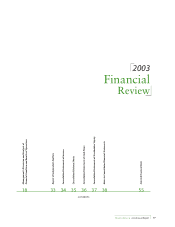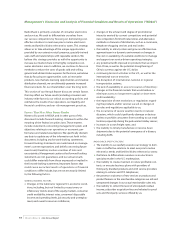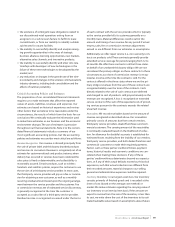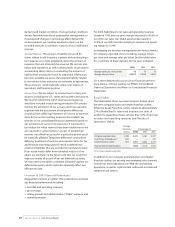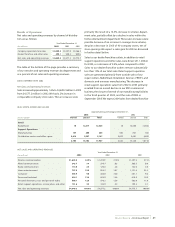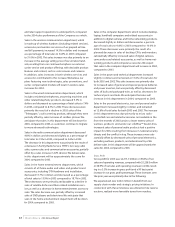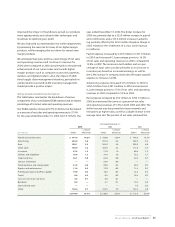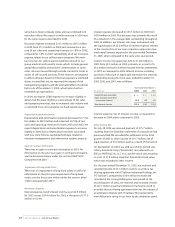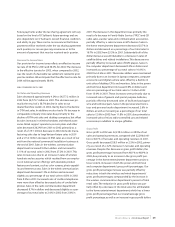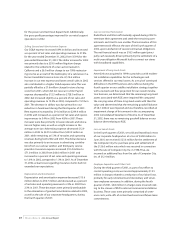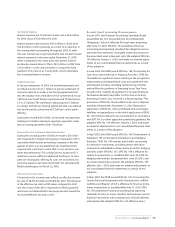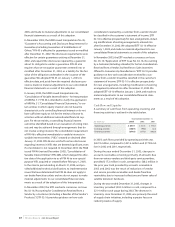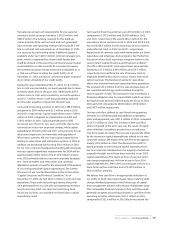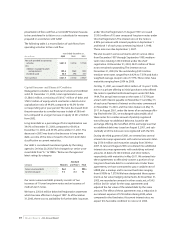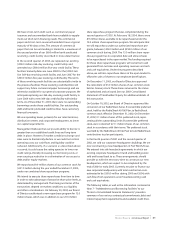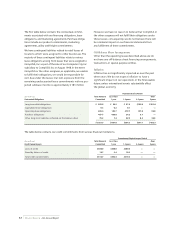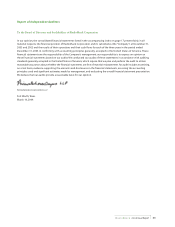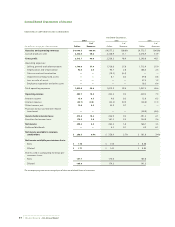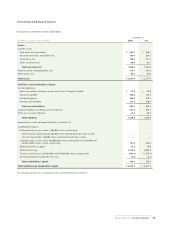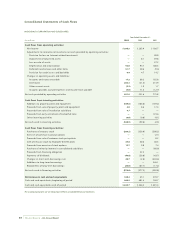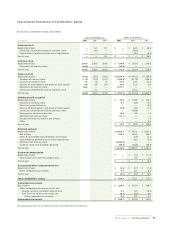Radio Shack 2003 Annual Report Download - page 29
Download and view the complete annual report
Please find page 29 of the 2003 Radio Shack annual report below. You can navigate through the pages in the report by either clicking on the pages listed below, or by using the keyword search tool below to find specific information within the annual report.
RADIOSHACK 2003 Annual Report 27
Net Interest Expense
Interest expense, net of interest income, was $34.4 million
for 2002 versus $37.8 million for 2001.
Interest expense decreased to $43.4 million in 2002 from
$50.8 million in 2001, primarily as a result of a reduction in
the average debt outstanding throughout 2002. In addi-
tion, our interest rate swap instruments also lowered overall
interest expense for the year ended December 31, 2002,
when compared to the same prior year period. Interest
income decreased almost 31% to $9.0 million in 2002 from
$13.0 million in 2001, due primarily to CompUSA’s early
payment of its note to us in June 2001, which eliminated
the associated interest income.
Other Income, Net
In the second quarter of 2002, we received payments and
recorded income of $27.7 million in partial settlement of
amounts owed to us under a tax sharing agreement that
was the subject of an arbitration which commenced in July
1999 and was styled Tandy Corporation and T.E. Electronics,
L.P. vs. O’Sullivan.The arbitration ruling requires O’Sullivan
to comply with the tax sharing agreement that was entered
into by the parties at the time of O’Sullivan’s initial public
offering.
During the second half of 2002, we received two payments
totaling $6.2 million relating to quarterly payments under
the tax sharing agreement with O’Sullivan.
Provision for Loss on Internet-Related Investment
During the second quarter of 2000, we made a $30.0 mil-
lion investment in Digital:Convergence Corporation (“DC”),
a privately-held Internet technology company. In the first
quarter of 2001, we concluded that our investment had
experienced a decline in value that, in our opinion, was
other than temporary.This conclusion was based on DC’s
inability to secure sufficient additional funding or to com-
plete an initial public offering. As such, we recorded a loss
provision equal to our initial investment. DC subsequently
filed for bankruptcy on March 22, 2002.
Provision for Income Taxes
Our provision for income taxes reflects an effective income
tax rate of 38.0% for 2002 and 42.8% for 2001.The decrease
in the effective tax rate in 2002 when compared to 2001
was the result of the 2001 impairment of RSIS goodwill,
which was not deductible for tax purposes and caused the
increased effective tax rate in 2001.
Recently Issued Accounting Pronouncements
In June 2001, the Financial Accounting Standards Board
issued SFAS No. 143,“Accounting for Asset Retirement
Obligations,”which is effective for fiscal years beginning
after June 15, 2002. SFAS No. 143 establishes financial
accounting and reporting standards for obligations associ-
ated with the retirement of tangible long-lived assets and
the associated asset retirement costs.We adopted SFAS No.
143 effective January 1, 2003, and made no material adjust-
ments to our consolidated financial statements as a result
of this adoption.
In June 2002, the FASB issued SFAS No. 146,“Accounting for
Costs Associated with Exit or Disposal Activities.” SFAS No.
146 addresses significant issues relating to the recognition,
measurement, and reporting of costs associated with exit
and disposal activities, including restructuring activities,
and nullifies the guidance in Emerging Issues Task Force
Issue No. 94-3,“Liability Recognition for Certain Employee
Termination Benefits and Other Costs to Exit an Activity
(Including Certain Costs Incurred in a Restructuring).”The
provisions of SFAS No. 146 are effective for exit or disposal
activities initiated after December 31, 2002. Retroactive
application of SFAS No. 146 is prohibited and, accordingly,
liabilities recognized prior to the initial application of SFAS
No.146 should continue to be accounted for in accordance
with EITF 94-3 or other applicable preexisting guidance.We
adopted SFAS No.146 effective January 1, 2003, and made
no material adjustments to our consolidated financial state-
ments as a result of this adoption.
In April 2003, the FASB issued SFAS No. 149,“Amendment of
Statement 133 on Derivative Instruments and Hedging
Activities.”SFAS No. 149 amends and clarifies accounting
for derivative instruments, including certain derivative
instruments embedded in other contracts, and for hedging
activities under SFAS No. 133. SFAS No. 149 is effective for
contracts entered into or modified after June 30, 2003, for
hedging relationships designated after June 30, 2003, and
to certain preexisting contracts.We adopted SFAS No. 149
effective July 1, 2003, and made no material adjustments to
our consolidated financial statements as a result of this
adoption.
In May 2003, the FASB issued SFAS No. 150,“Accounting for
Certain Financial Instruments with Characteristics of Both
Liabilities and Equity,”which is effective for financial instru-
ments entered into or modified after May 31, 2003. SFAS
No.150 establishes financial accounting and reporting
standards for how an issuer classifies and measures certain
financial instruments with characteristics of both liabilities
and equities.We adopted SFAS No. 150 effective June 1,


